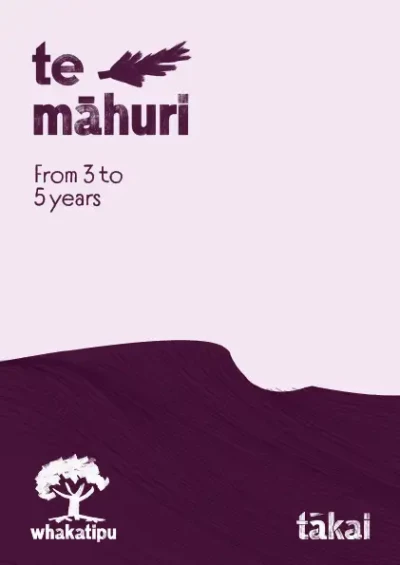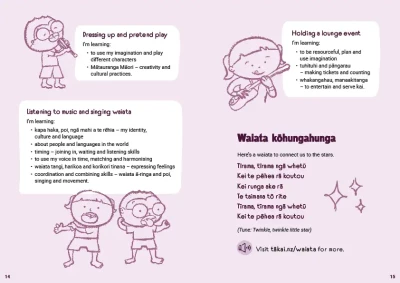
Music with children aged 3–5
Ideas for creating and sharing musical experiences with tamariki.
Music is a wonderful opportunity to have fun, share attention and to learn. For background, refer to some of the other articles on our website:
- Waiata mai — Sing to me (multiple ages)
- Music and movement (19–24 months)
There are ideas for making music with babies and children, and information about how musical experiences contribute to their learning.
Important developmental characteristics
What developmental characteristics of this 3–5-year age group are important?
- Learning to cooperate with others
This is the stage when tamariki are learning about getting on with others. They’re practising taking turns and waiting for their turn. Participating in musical activities such as singing and playing instruments requires that children listen and wait until it’s their turn to play. - Using their imagination
Pretending is a big part of the lives of tamariki at this age. Music and sound-making give lots of opportunities to use imagination. For example, ‘Pretend we’re at the moana, what can you hear?’ - Being creative
‘How can we make the sound of water, the crunch of sand, the cries of the birds?’ - Enjoying humour
Tamariki enjoy silly words and jokes, and this can easily be included in music. ‘The wheels on the bus go crash, bang, wallop’, for example. - Being active and energetic
Singing and dancing and making all sorts of sounds appeal to this age group.
In Whakatipu Te Māhuri (page 14), ‘Ngā mahi a whānau’ gives a summary of the wide range of learning opportunities that music provides, including:
- language
- cultural identity
- physical coordination
- expressing feelings
- learning to cooperate.
All of these opportunities are wrapped up with having fun.
Watch this TEDx talk by Anita Collins to find out about some of the benefits children experience from music.
Musical experiences for 3–5-year-olds
Singing
- Waiata can be made up about anything, anywhere, using known tunes or creating new simple tunes.
- Try songs from different cultures and communities.
- Attend kapa haka performances, sing in church, go to children’s music groups and attend community events such as ‘carols in the park’.
Making sounds
- Body percussion – try clapping, stamping, slapping, clicking fingers, clicking tongues, humming or making animal sounds.
- Make sounds with objects by shaking, banging, scraping, crumpling and spinning.
- Make sound effects when storytelling.
- Make your own instruments – use recycled and found objects to make simple instruments.
- Shakers – try plastic jars and tins with lids containing different small objects.
- Scrapers – find things with different surfaces and use other objects to scrape or scratch them; for example, corrugated cardboard and a piece of wood.
- Drums – try pots and pans, tins and boxes. Turn them over and try different strikers such as wooden spoons, brushes or fingers.
- Trumpets – try rolled up paper and cardboard tubes to blow or sing through.
- Rubber band banjo – stretch rubber bands around a small to medium-sized container and strum or pluck.
Moving to music
- Dance to music on YouTube, the radio or CDs.
- Add ribbons or scarves for active arm movements.
- Use an instrument you’ve made or that you own.
Musical games
- Statues – play music and when the music stops, tamariki turn into statues. If you move, you’re ‘out’.
- Musical chairs or cushions – have one less than the number of people playing. When the music stops, tamariki run to sit on an empty chair or cushion. An adult takes a chair or cushion away after each round so there are fewer and fewer left. The last person left wins. (They could be the ‘remover’ for the next game.)
Experimenting with sounds
- ‘What was that?’ An adult and tamaiti collect some small items made of different materials and drop them one at a time in a tin. The tamaiti wears a blindfold or turns away so they can’t see. The aim is to guess which item made the sound. Try things like a small stone, a leaf, a peg, a marble, a seed, or a piece of Lego.
- Find a tall glass bottle or jar, a funnel and a teaspoon. Put some water in an empty plastic milk container through the funnel, and as you slowly pour the water into the bottle, gently tap its sides and listen carefully to the way the sound changes. Talk about why they think this happens.
- Gather some glass containers of the same size (old jam jars work). Put different amounts of water in each, then tap the containers gently and listen to the sound. Ask which bottle sounds high or low. Try putting the bottles in order from highest sound to the lowest. What do they notice about the amount of water in the bottles? How can we make sounds higher or lower?
 pdf 11 MB
pdf 11 MB












